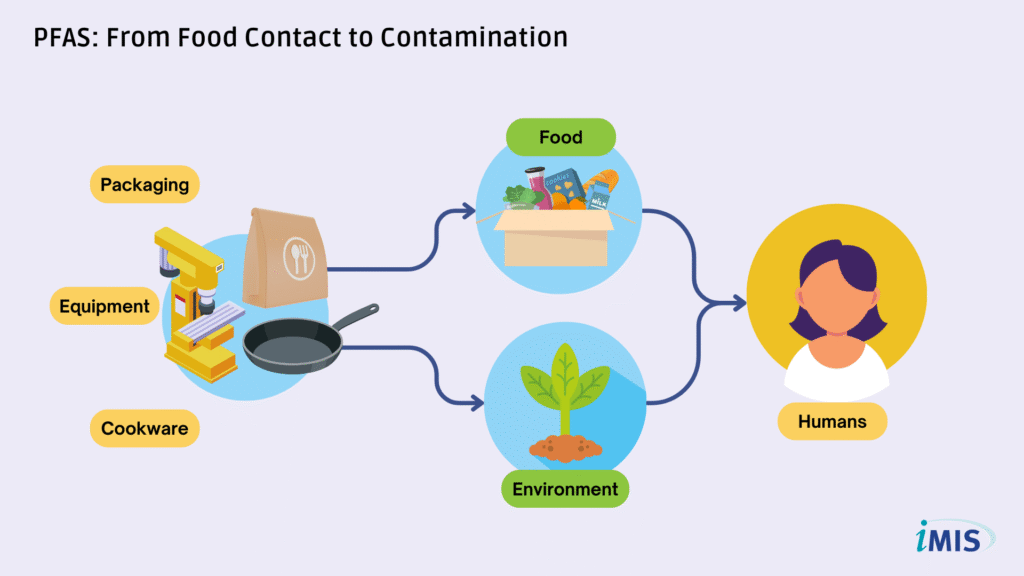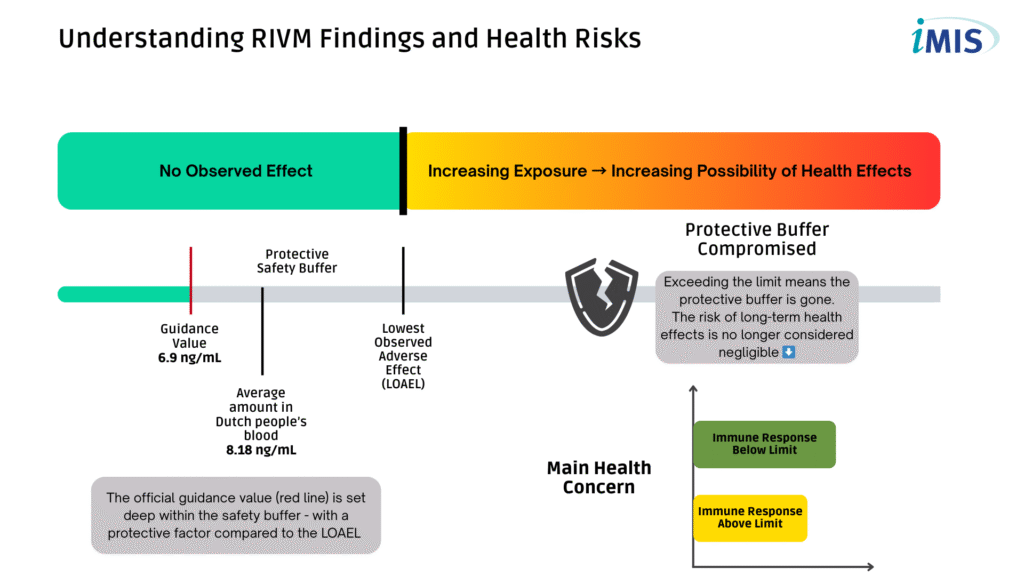Introduction
The Dutch National Institute for Public Health and the Environment (RIVM) has released a new report on the levels of PFAS in the blood of the Dutch population.
The findings confirm previous research: nearly everyone in the Netherlands has higher concentrations of these substances in their blood than the established health-based guidance value.
While this news may sound concerning, it is important to understand what the report actually says, what it means for long-term health, and what the implications are for food safety and the food industry.
What are PFAS?
Per- and polyfluoroalkyl substances (PFAS) are a large family of man-made chemicals. Because of their water- and grease-resistant properties, they are used in thousands of products, including non-stick coatings, food packaging, and clothing. Through manufacturing processes and the use of these products, PFAS can enter the soil, water, and air. People are then exposed to them through various routes, primarily via food and drinking water, but also through skin contact and inhalation.

Key Findings from the RIVM Report
Based on an analysis of blood samples from 2016-2017, the RIVM has provided the first nationwide overview of PFAS exposure in the Netherlands. The key findings are:
- Widespread exposure: The Dutch population is exposed to multiple PFAS simultaneously. Nearly all blood samples contained at least seven distinct compounds, including PFOA and PFOS.
- Exceeding health guidelines: A significant portion of the population has PFAS blood concentrations above the health-based guidance value established by EFSA. This confirms previous RIVM and EFSA assessments that people are exposed to too much PFAS.
- Health implications: When the guidance value is exceeded, long-term adverse effects on the immune system cannot be ruled out. The EFSA limit is specifically set to protect against a reduced vaccination response in children.
- Dominant substances: PFOS is the substance found in the highest concentrations, followed by PFOA. These are persistent “legacy” compounds with long half-lives in the human body.
- Regional hotspots: The report confirms that inhabitants of the Dordrecht and Westerschelde regions have higher blood concentrations of certain PFAS compared to the rest of the Netherlands.
Assessing the PFAS Risk: What the Numbers Mean
The RIVM report confirms that from a public health standpoint, the risk is real, but it’s crucial to understand its nature. The concern is not about immediate illness but about the potential effects of long-term, chronic exposure on the population.
Understanding the Safe Limit
To assess risk, scientists use a Health-Based Guidance Value (HBM-GV). The European Food Safety Authority (EFSA) has set this limit at 6.9 ng/mL of blood serum for the combined total of four major PFAS (PFOA, PFNA, PFHxS, and PFOS).
This is a precautionary threshold designed to protect the most sensitive groups, specifically by preventing a reduced immune system response in children exposed via their mothers. Exceeding this value means that a negative effect on the immune system cannot be ruled out.

Note on Safety Factors and Precaution
Health-based guidance values are precautionary limits, not absolute thresholds for harm. They are established by applying significant safety factors to the lowest level where an adverse effect was observed in scientific studies (the LOAEL). This creates a protective buffer to account for uncertainties and protect sensitive individuals.
Exceeding this limit erodes the buffer. While this does not predict harm in any single person, it means the long-term health risk to the population is no longer considered negligible, which is why it prompts concern from authorities like RIVM and EFSA.
Comparing Exposure Data to the Health Limit
So, how does the Dutch population measure up against this precautionary limit? The RIVM report shows that while a person with average exposure has PFAS levels just under this limit, individuals with higher exposure are significantly over it.
More importantly, the RIVM’s overall analysis concluded that:
- When looking at the four main PFAS, 71% of adults and 42% of women of childbearing age have blood levels that exceed the EFSA guidance value.
- When a more advanced method, including nine types of PFAS, is used, that number rises to nearly the entire population (98-99%).
How Safety Concerns Drives Marketing
When reports like this highlight a widespread health concern, it naturally creates a demand for safer products. While this can lead to positive innovation, it also opens the door for marketing strategies that leverage consumer uncertainty. Consumers should be aware of several common tactics:
- “Free-From” claims: You will increasingly see products marketed as “PFAS-Free.” This can be a valuable quality attribute, but it’s wise to be critical. Is the claim certified by an independent third party? Does avoiding it in one product significantly reduce your overall exposure, or are the primary sources elsewhere?
- Selling quick fixes: Companies may market products like special water filters or “detox” supplements that claim to remove PFAS from your water or your body. Consumers should seek independent scientific evidence that these products work as advertised for the specific concern. Health authorities do not currently recommend such products as a solution for individuals with high PFAS levels.
- Creating a “problem-solution” narrative: Some marketing implies that all conventional products are dangerous and that only their premium product is a safe alternative. This often exaggerates the problem to make their solution seem more necessary.
The best approach for consumers is to rely on guidance from public health agencies for a balanced view of the risk, rather than marketing materials.
Conclusion: PFAS is a Real but Long-Term Concern
While the concern is about the long-term health of the population, not an acute danger to an individual, the data shows the risk is not fabricated. The RIVM’s findings confirm a widespread public health issue: current exposure levels are above the point where we can be certain there are no long-term consequences, reinforcing the need for broad measures to reduce exposure for everyone.
The Road Ahead for the Food Industry
This report, and the growing body of research on PFAS, signals a clear direction for the food sector. While the responsibility for managing these “forever chemicals” is broad, the food industry has a crucial part to play.
- Increased regulatory pressure: The Dutch government has classified all PFAS as Substances of Very High Concern (ZZS). At the European level, a proposal is underway for a near-total ban on the production and use of PFAS under the REACH regulation. Food businesses must prepare for a future where PFAS are heavily restricted or banned.
- Supply chain management: Understanding and managing the supply chain is more critical than ever. Raw materials sourced from areas with known industrial contamination pose a higher risk. Proactive businesses should be investigating the origin of their ingredients to mitigate potential contamination.
- Consumer awareness: Public awareness of PFAS is growing. Consumer demand for transparency and assurance that their food is safe will likely increase. Being proactive about managing PFAS can become a competitive advantage.
The report underscores that PFAS contamination is a widespread, systemic issue rather than an acute crisis. The solution is not individual action but a broad, collective approach involving stricter regulations, industrial responsibility, and continued monitoring. For the food industry, the message is clear: the time to be proactive about understanding and managing PFAS in the supply chain is now.
Staying Updated on Chemical Hazards with iMIS food
The findings on PFAS highlight the ongoing challenge for food businesses to stay informed about emerging chemical hazards. To support the industry, iMIS Food maintains comprehensive hazards tables, including for chemical hazards. These tables are continuously updated with the latest scientific information.
Using this regularly updated resource helps ensure your food safety system remains robust, compliant, and prepared to manage risks like those posed by PFAS and other potential contaminants.
Check and download the table from the link below ⬇️
Stay Connected: Join our Newsletter!
Ready to learn more? Subscribe to our newsletter for the latest updates, tips, and exclusive content delivered straight to your inbox!
Sources
- [1] Bil, W., McKeon, H. P., Chen, G., Sam, M. L. S. P., Grift, I. D., van der Klis, F. R. M., Vos, E. R. A., Schipper, M., de Wit-Bos, L., Mengelers, M., Bokkers, B. G. H., & Nederlof, R. (2025, June 25). Pfas in bloed van de Nederlandse bevolking (RIVM-briefrapport 2025-0094). Rijksinstituut voor Volksgezondheid en Milieu. https://www.rivm.nl/publicaties/pfas-in-bloed-van-nederlandse-bevolking
- [2] Rijksinstituut voor Volksgezondheid en Milieu. (2025, June 25). Pfas. https://www.rivm.nl/pfas
Related articles to New RIVM Report on PFAS: What it Means for Food Safety
Many customers and visitors to this page 'New RIVM Report on PFAS: What it Means for Food Safety' also viewed the articles and manuals listed below:
